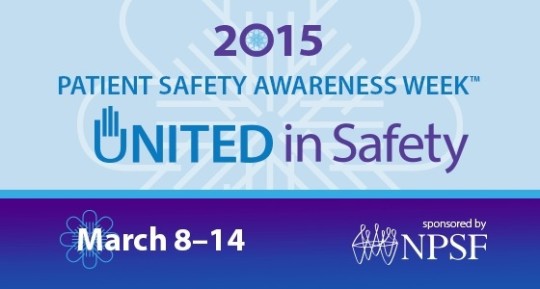This week is the annual Patient Safety Awareness Week, presented by the National Patient Safety Foundation, a non-profit that I like and support. As Lean thinkers, I hope we'd recognize that the amount of patient harm and death that's caused by preventable medical errors is a huge problem around the world.
When we ask “why is there so much harm?” there are many answers – causes and root causes. There's no simple answer to the question of why so much harm occurs and why, sometimes, it seems like not enough progress is being made. One contributing factor, I think, is the lack of public awareness about this problem and the scale of it.

I call this “the patient safety crisis,” but it's also the biggest crisis that nobody knows about.
That lack of awareness leads to a lack of pressure to improve — not that “pressure to improve” is ever enough to fix a system, but I think it's necessary.
See a post I wrote about Patient Safety Awareness week in 2012. We still have a long way to go.
It's easy for hospitals to say they “always make patient safety a top priority,” but we need to hear more stories about how hospitals actually live that every day.
As somebody who works in hospitals, is on the board of a patient safety foundation, and one who pays attention to news stories about patient harm (via Google alerts… these stories get coverage, but mainly as one-off incident stories), it's easy to get discouraged and feel down about the state of patient safety. Too many errors seem to get repeated in different hospitals. Too many of the organizational culture factors that are known to inhibit safety improvement seem to go unaddressed.
Bad systems and processes, along with chaotic work environments and fatigued staff, lead to a great deal of harm. Organizations that “name, blame, and shame” do more to get people to hide and cover up risks and problems than they do to really improve safety.
There are uplifting moments where you see the potential of healthcare safety improvement, through Lean and other methods. I've worked with hospitals where problems like pressure ulcers (bed sores) were pretty quickly reduced by 80%. There are so many case studies and stories told at conferences about 70 to 90% reductions in different types of harm. I've collected some success stories here.
It's possible to improve, we're just not seeing enough of it in enough hospitals to really make a dent in the national harm figures.
Recently, within the team at KaiNexus, we've been having discussions about the Simon Sinek book Start with Why: How Great Leaders Inspire Everyone to Take Action. We've been articulating our “why” statements – why we do the work that we do. Helping patients and caregivers ranks at the top of the list for me and we share that passion for helping people who want to improve.
While thinking about the patient safety crisis the other day, I was feeling a bit down and I looked on YouTube for success stories or inspiring stories about nurses caring for patients (I was working from home, so I didn't have a hospital “gemba” to visit).
I found this video and started watching:
The video features kids and staff (mostly kids) who are patients at the Children's Hospital at Dartmouth-Hitchcock. They're doing a lip sync video to the song “Roar” by Katy Perry. Even if you don't care for her music, watch the video on mute (if your organization hasn't blocked access to YouTube).

I'm not afraid to admit that when I watched the video, I started bawling pretty uncontrollably about a minute into it… and I did again when I went back to grab the screen capture of a roaring kid, as shown at left.
Seeing those brave kids, those sick kids who are fighting all sorts of diseases that I've never had to face… seeing their smiles and their ability to have fun… and to see the nurses and the managers who work so hard to take care of them… and those people work way harder than they have to and they don't get treated as well as they should.
It's easy to start crying on their behalf. The video is, of course, not depressing on its own… but seeing those faces made think about those who battle back from their disease, only to die as the result of a preventable medical error (listen to my podcasts with Chris Jerry, whose daughter Emily was one of those kids who died unnecessarily).
These kids in the video are far more brave and tough than I've ever had to be. So are the people who work so hard to care for them — these are great people working in broken systems.
There are so many “bad news” stories in healthcare, it sometimes gets a bit overwhelming. I had somebody email me last week, asking basically “how can we succeed with Lean and quality improvement when [the province] is laying off people and outsourcing jobs because it's cheaper?” There are too many stories about people whose loved ones have been stolen away because of preventable medical errors. There are too people who watch our KaiNexus webinars and ask, “How can I create a culture of continuous improvement when my managers don't listen to my ideas?”
There are still so many things unnecessarily wrong in healthcare. Preventable management errors, if you will.
But if I ever get down or start feeling sorry for myself… I'm going to watch those kids in that video and try to roar a little bit myself.
Thank you everybody for the work that you do. To everybody who is helping improve healthcare, let's never forget that we want to make people roar…
Please scroll down (or click) to post a comment. Connect with me on LinkedIn.
Let’s work together to build a culture of continuous improvement and psychological safety. If you're a leader looking to create lasting change—not just projects—I help organizations:
- Engage people at all levels in sustainable improvement
- Shift from fear of mistakes to learning from them
- Apply Lean thinking in practical, people-centered ways
Interested in coaching or a keynote talk? Let’s start a conversation.








![When Was the Last Time a Leader Around You Admitted They Were Wrong? [Poll]](https://www.leanblog.org/wp-content/uploads/2025/07/Lean-Blog-Post-Cover-Image-2025-07-01T212509.843-100x75.jpg)

Here is another similar video from Seattle Children’s Hospital where patients lip synch Kelly Clarkson’s “STRONGER”. These videos do tug at the heart strings!
Thanks, Brian. That’s a great video too.
I did keep from getting too emotional, I guess… I noticed the two-bin kanban system racks in the background at one point…
Pretty powerful stuff. I’ve been “preaching” to manufacturing folks that Safety is the “love of manufacturing,” but this video is worth a thousand of my words. We often see children as “precious,” but if you think about it, everybody is somebody’s loved one. And if we can start to consider a patient, a front-line worker, really anyone that we work with as a precious person as well, perhaps, we will re-prioritize safety – in all fields.
Hi Bart – people use the word “love” much more freely in healthcare than in manufacturing (said as somebody who has worked in both environments).
I agree with Paul O’Neill, who says safety is a moral obligation. It’s a human obligation that needs to come before everything else.
[…] And I’ll again post this video from last year that really touched me: […]